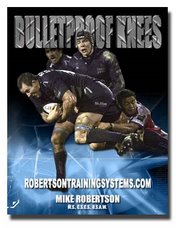As promised, I'm working on making the blog a little bit more oganized. You'll see some housekeeping on the right side (at least half of the other blog links didn't work!), and hopefully the content will be a little bit more streamlined as well.
Today, I'd like to discuss the training of MMA athletes. As many of you already know I've been working with Dan New here at I-FAST, and Dan has a huge fight coming up in two weeks against Jason "The Human Weapon" Chambers.
One of the primary reasons I took up Krav Maga a while back was to better understand what it's like to actually train for MMA. I've played nearly every sport imaginable in my life, and I feel that makes me a better coach when working with those athletes. You don't have to be an all-star, mind you - rather, it puts you in your athletes shoes so you have a better idea of how to program for them. I wanted to have a better idea of Dan's training so that I could be a better coach for him.
I quickly learned that when training for MMA, you need a lot of different physical qualities:
- Flexibility/mobility
- Endurance
- Strength
- Power
- Agility
And beyond these separate physical qualities, you also need a blending of them as well! In other words, you not only need power and endurance, but you also need power-endurance if you want to knock someone out in the 3rd or 5th round. Therefore, writing programming for an MMA athlete can be very challenging.
If you're working with an MMA fighter, the first thing you need to do is assess them. This could be a static assessment, a dynamic assessment, or simply watching them spar or fight. From there, you need to talk to the athlete and determine what he/she feels their weaknesses are. Obviously conditioning is always going to be important, but if they're weak as a kitten for their bodyweight/class, you need to improve upon that. Bill talks a great deal about assessments in our Indy Seminar Series.
With Dan, we've put a real premium on improving his strength and power while maintaining, or even improving slightly, his conditioning. This would be easy if I only had him training in the weight room, but when you add in specific training for Muay Thai, BJJ and just general mat/conditioning work, that's a lot of hours in the gym! The best thing you can do is try and learn about your athletes - how they're feeling on any given day, what kind of loading they'll respond best to, etc. This is cybernetic periodization at its finest.
The bottom line is preparing someone for MMA is not an easy gig - at the very least start with a needs analysis to determine strengths/weaknesses and begin your journey there. As training progresses, don't forget to re-evaluate and determine how physical qualities have changed, and how the training regimen should change to help them be at their best on fight night.
Stay strong
MR
High Octane Corrective Exercise and Performance Enhancement | www.RobertsonTrainingSystems.com
Subscribe to:
Post Comments (Atom)









1 comment:
Mike,
Love the blog! Can you talk a little bit more about what you mean by 'cybernetic programming', and give us some examples of how you use that?
Thanks!
Yudi Kerbel
NASM-CPT
Post a Comment